From its humble beginnings at barbecues and tailgates, the bean bag tossing game known as cornhole is now being played at nationally televised tournaments, and competitive leagues are popping up all over the country, including the Bay Area and Sacramento.
What to Know
- Though the game might be hundreds of years old, the modern version of cornhole has its roots in the American South and Midwest, with some tracing the start of its current popularity to Cincinnati
- The American Cornhole League, founded in 2015, is the second U.S. governing body to emerge for the sport of cornhole, and sets rules for the game and standards for the bags and boards used in competitive play
- The cornhole craze has hit California, with officially-sanctioned local leagues emerging around the state, and a growing number of professional ACL players based in the Golden State who travel the country to appear in televised national tournaments
The sun was shining outside, and the students in Mr. Voyer's sixth grade classroom were getting restless.
With just days left until summer vacation, spring fever was in full effect at San Joaquin Elementary in Stockton. But in the battle to keep his students' attention, Mr. Voyer had one more trick up his sleeve.
"Pretend like you're balancing a plate on your hand," he told the class.
Then he picked up a one-pound square bean bag and placed it on a student's hand in the front row. It was the start of what promised to be an unforgettable lesson in physical education.

Part Teacher, Part Pro Athlete
Nate Voyer isn't just a sixth grade teacher. He's also a professional player in the American Cornhole League, currently in his rookie season. In fact, after many years as an assistant principal, Voyer says moving back into the classroom has allowed him to more easily balance his education career with his brand new sporting career. The school district has even assigned a dedicated substitute teacher to fill in whenever he has to miss class for a tournament.

Voyer's students are some of his biggest fans. His class watched together as he made his television debut, playing doubles alongside former 49ers tight end Vernon Davis. Though the pair didn't win the tournament, Voyer made an impressive showing, throwing the fan-favorite "airmail" shot three times in a row.
The Scene
Basic Rules of Cornhole
The game of tossing bean bags at a small round hole in a slanted wooden board seems simple enough.
"I don't care if you're 7 or 70," Voyer said. "If you can throw a 1-pound bag 27 feet, you can play cornhole."
Players just call them "bags" because they don't actually contain beans — or corn. The American Cornhole League requires the bags to be 6 inches square, and filled with plastic resin beads — almost exactly 1 pound of them. The bags are tossed 27 feet at a slanted 2-by-4 foot board with a 6-inch round hole near the top.
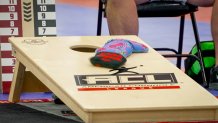
Players take turns throwing four bags per round. A bag in the hole is worth three points, and a bag on the board is worth one point. Cornhole uses "cancel scoring" so if Player A gets two bags in the hole, and Player B gets three, the first two shots cancel out, and Player B gets 3 points for that round. The first player to reach 21 wins.
Standing at the white board in front of his class, Voyer explained that at its highest levels, cornhole is as much a game of strategy as a game of skill. As a young and growing sport, players are innovating new kinds of shots every season. But for now, there are six basic shots to know about:
Types of Shots in Cornhole
- Slide: The most common shot in cornhole, the slide shot hits the center of the board, and then slides into the hole.
- Block: Thrown either intentionally or by accident, a block shot lands in the center of the board, but stops before dropping into the hole — creating an obstacle for your opponent.
- Airmail: Cornhole's equivalent to a swish in basketball, an airmail goes high in the air and drops straight into the hole — flying over any blocking bags that might be in the way.
- Push: Often thrown to "clean up" at the end of a round, a push shot shoves a blocking bag — hopefully your own — into the hole.
- Cut: Sometimes thrown by accident at the novice level, experts use the cut shot to steer around obstacles — throwing bags at an angle so that they hit the board and jump diagonally toward the hole.
- Roll/Flop: Among the newest advanced shots to become trendy in professional play, a roll or flop shot hits the board in front of a blocking bag, and then catapults over it into the hole.
Harder Than It Looks
After a brief classroom explanation, Voyer's students were ready to line up and head outside. It took them only a few throws to realize that 27 feet is an awfully long way to toss something at such a small target. Though all of them had experienced cornhole before at a backyard gathering or tailgate party, informal cornhole is often played at shorter distances, with lighter bags. Voyer explained the proper technique:
"It's like a pendulum, like on a clock," he said, demonstrating the underhand swinging motion with a straight arm and no bend in his elbow — and then a quick flick of the wrist as the bag left his hand. "At the very end, it's like a frisbee movement, and you're throwing like that ... because we want a nice pancake style bag that will land on the board flat and slide into the hole."

Throwing bags that fly high in the air and land flat on the board is a skill that relies heavily on muscle memory, Voyer said. Many professionals practice daily to maintain their accuracy.
"We have some guys that throw a thousand bags a day," said Joseph Fields, who directs the American Cornhole League's Western Confernce — the conference that includes California.
"Anyone Can Play, and Anyone Can Win"
Fields spoke in an interview at the ACL Open tournament in Sacramento, where Voyer and other serious players from Northern California showed up to compete. Cornhole pros from around the country travel to tournaments in a different city almost every weekend during the season, giving amateur players a chance to take them on or team up with them in the "blind draw" doubles round, where players are matched up at random.
The blind draw at ACL Open tournaments is emblematic of the league's motto: "Anyone Can Play, and Anyone Can Win." In the American Cornhole League, there are no age groups and no gender divisions: players are separated only by skill level, and the top 256 players can compete as professionals for serious prize money (which totaled more than half a million dollars across all the tournaments in 2021).
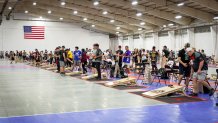
"We've got some kids as young as 12, up to age 70, early 70s," said Jodi Lim, a professional player from San Diego who's 52 years old. "I'm playing against some of the pros who are my daughter's age — 20, 21, 22."
Lim said that like many other pros his age, he found cornhole after years of playing other sports that require good hand-eye coordination. Most recently, he said, he played on the Golf Channel's amateur tour. But unlike the other sports he's played, Lim said there's no single type of athlete who's good at cornhole.
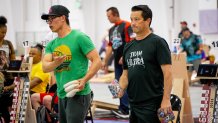
"I think (cornhole has) a pretty even playing field across the ages as well as physiques, sizes," Lim said. "One of the things that helped me in golf, too, is I was able to stay calm under pressure, not get too frustrated if I missed a shot, and just concentrate on the next shot. And similar to golf, you're just trying to put something in the hole."
Rising Stars and Evolving Technology
Some of cornhole's youngest royalty also made an appearance at the Sacramento tournament, including 19-year-old Trey Burchfield. Burchfield is the only player to have both a singles and a doubles ACL world championship under his belt. He's nicknamed "The Robot" for his uncanny ability to remain cool, collected and consistently accurate under intense pressure.
Unlike Voyer, whose signature shot is the airmail, Burchfield plays an offense-focused game that's centered around the slide shot — mixing in cut and roll shots to steer around his opponents' bags.
"Pretty much just sliding it in the hole, putting every bag I can in the hole," he said. "If they go in the hole, you can't lose. So that's my strategy."

Also at the tournament was Ryan Windsor — a 25-year-old phenom who recently began selling his own signature line of cornhole bags.
"There's just thousands and thousands of different materials," Windsor said of the possibilities when designing high-performance bags.
Although all cornhole bags must be the same size and weight to qualify for tournament play, there are no rules restricting the materials they can be made out of. Many bags feature a fast side and a slow side: one side that slides quickly, and one side that hits the board and stops. Each season, ACL officials release a list of approved bag manufacturers and models that have passed their inspection, and every approved bag must bear the official ACL stamp to be allowed in a tournament.
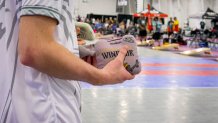
The list of approved bags is long, and with good reason: The best bag for you depends on how you play.
"I'm like a really defensive player," Windsor said, placing his style in stark contrast to Burchfield's. "So I'll throw sticky bags, compared to really slick bags. You know, a lot of people will just go for the hole every time, but I like to post them up in front of the hole."

While Burchfield said he switched to an even slicker bag for the current season, Windsor has been dialing in his block shot, throwing bags sticky-side-down so that they stop right in front of the hole with startling accuracy.
All in the Timing
After school on Tuesdays, Voyer hangs up his polo shirt and dons his official ACL jersey. Tuesday night is league night for the Port City Baggers — the ACL-sanctioned local cornhole league he and his wife started about three years ago. The league now attracts from 60 to 100 people each time it meets, Voyer said, including visitors from clubs in neighboring cities.
Like Voyer, many of the Baggers discovered they had a knack for cornhole when they played it in someone's backyard. Then, after showing up to a league night out of sheer curiosity, they were hit with the drive to compete.
"We were just hooked from then on," said Brent Alger, who attended his first Tuesday night tournament at Voyer's urging. "And then COVID hit, so it was one of the things we could do."
Indeed, Voyer said it was the timing of the COVID-19 pandemic, just as cornhole was already beginning to expand its reach, that propelled the sport into the spotlight.
"During the pandemic," he said, "boards and bags were on backorder, because people were home, but people didn't want to just be inside."
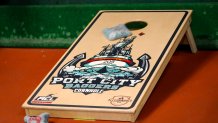
Because the game is inexpensive and easy to learn, Voyer said it became a popular pandemic pastime — and players with a lot of time on their hands improved quickly. And because cornhole doesn't require close contact between players, the American Cornhole League quickly devised a set of COVID protocols that would allow it to safely hold tournaments for a television audience that was clamoring for live sports — and networks that desperately needed content.
In turn, Voyer said, the television exposure helped to grow even more interest in local leagues.
"Three years ago, when we started our league, the next league that was close to us was in West Sacramento," he said. "Now there are leagues in Brentwood, Pleasanton, Tracy, Manteca, Elk Grove, Galt, Bay Area Baggers in South San Francisco. There's just a lot of great, great people starting leagues because it's thriving."
An Olympic Future?
By the end of their P.E. class playing cornhole, Voyer's sixth grade students were already showing improvement.
"I just airmailed one!" exclaimed one student, overjoyed at his improvement in the span of less than an hour.
"I want to be the next Mr. Voyer!" proclaimed another student with confidence, as he headed back into the classroom.
Asked if he wanted to play cornhole professionally, a third student confessed he had other ambitions: "I don't know — I want to be an orthodontist!"
But the American Cornhole League has its own ambition, and it's laser-focused.
"The goal for the ACL is trying to make it an Olympic sport," Voyer said. "It's wild, but it's catching on!"
Voyer's not sure if there are Olympic medals in his own future, but for now, he said he's satisfied with a different kind of victory:
"This last week that I've brought boards from our league to play (at school), I actually had perfect attendance three days in this last week," he said. "So I'm actually getting kids to come to school. I mean, I'll take that any day."



